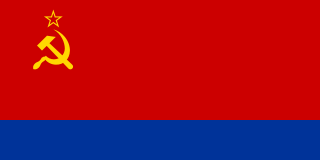
The Azerbaijan Soviet Socialist Republic, also referred to as the Azerbaijani Soviet Socialist Republic, Azerbaijan SSR, Azerbaijani SSR, AzSSR, Soviet Azerbaijan or simply Azerbaijan, was one of the constituent republics of the Soviet Union between 1922 and 1991. Created on 28 April 1920 when the Russian Soviet Federative Socialist Republic brought pro-Soviet figures to power in the region, the first two years of the Azerbaijani SSR were as an independent country until incorporation into the Transcaucasian SFSR, along with the Armenian SSR and the Georgian SSR.

Arran, also known as Aran, was a geographical name used in ancient and medieval times to signify a historically-Iranian region which lay within the triangle of land, lowland in the east and mountainous in the west, formed by the junction of the Kura and Aras rivers, including the highland and lowland Karabakh, Mil plain and parts of the Mughan plain. In pre-Islamic times, it corresponded roughly to the territory of the modern-day Republic of Azerbaijan. The term is the Middle Persian equivalent to the Greco-Roman Albania. It was known as Aghvania, Alvan-k in Armenian, and Al-ran in Arabic.
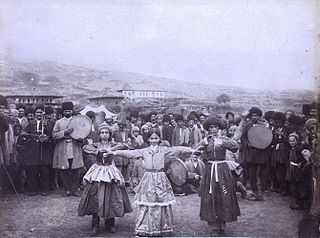
The Talysh people or Talyshis, Talyshes, Talyshs, Talishis, Talishes, Talishs, Talesh are an Iranian ethnic group, with the majority residing in Azerbaijan and a minority in Iran. They are the indigenous people of the Talish, a region on the western shore of the Caspian Sea shared between Azerbaijan and Iran. The main city of the Talysh people and their homeland is Lankaran, the majority of the population of which is ethnically Talysh. They speak the Talysh language, one of the Northwestern Iranian languages. The majority of Talyshis are Shiite Muslims.
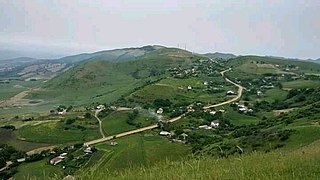
Jalilabad District is one of the 69 districts of Azerbaijan. It is located in the southeast of the country and belongs to the Lankaran-Astara Economic Region. The district borders the districts of Masally, Yardimli, Bilasuvar, and Neftchala. Its capital and largest city is Jalilabad. As of 2020, the district had a population of 225,300.

Lankaran District is one of the 69 districts of Azerbaijan. It is located in the south-east of the country, in the Lankaran-Astara Economic Region. The district borders the districts of Astara, Lerik, Masally, and Neftchala. Its capital and largest city is Lankaran, although the city is technically not part of the district and is subordinate to the Republic. As of 2022, the district had a population of 232,000.
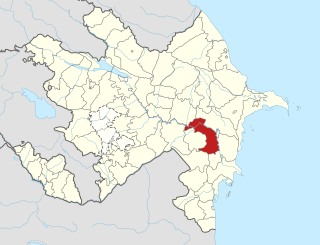
Sabirabad District is one of the 69 districts of Azerbaijan. Located in the centre of the country, it belongs to the Mil-Mughan Economic Region. The district borders the districts of Saatly, Imishli, Kurdamir, Hajigabul, Salyan, Bilasuvar, and the city of Shirvan. Its capital and largest city is Sabirabad. As of 2020, the district had a population of 178,800.

Yardimli District is one of the 69 districts of Azerbaijan. It is located in the south-east of the country and belongs to the Lankaran-Astara Economic Region. The district borders the districts of Jalilabad, Masally, Lerik, and the Ardabil Province of Iran. Its capital and largest city is Yardimli. As of 2020, the district had a population of 68,000.

Saingilo is a cultural region in the Caucasus. The term was invented in the nineteenth century to designate districts of Balakan, Zaqatala and Qakh — altogether an area of 4,780 km2 — currently part of Azerbaijan, with an Ingiloy Georgian minority.

The Azerbaijan Democratic Republic, also known as the Azerbaijan People's Republic, was the first secular democratic republic in the Turkic and Muslim worlds. The ADR was founded by the Azerbaijani National Council in Tiflis on 28 May 1918 after the collapse of the Transcaucasian Democratic Federative Republic, and ceased to exist on April 28, 1920. Its established borders were with Russia to the north, the Democratic Republic of Georgia to the north-west, the Republic of Armenia to the west, and Iran to the south. It had a population of around 3 million. Ganja was the temporary capital of the Republic as Baku was under Bolshevik control. The name of "Azerbaijan" which the leading Musavat party adopted, for political reasons, was, prior to the establishment of the Azerbaijan Democratic Republic in 1918, exclusively used to identify the adjacent region of contemporary northwestern Iran.
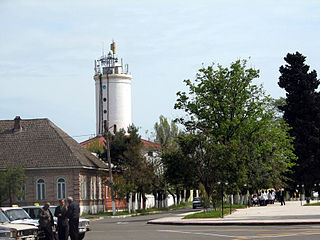
Lankaran is a city in Azerbaijan, on the coast of the Caspian Sea, near the southern border with Iran. As of 2021, the city had a population of 89,300. It is next to, but independent of, Lankaran District. The city forms a distinct first-order division of Azerbaijan.

The Baku Governorate, known before 1859 as the Shemakha Governorate, was a province (guberniya) of the Caucasus Viceroyalty of the Russian Empire, with its center in the booming metropolis and Caspian Sea port of Baku. Area (1897): 34,400 sq. versts, population (1897): 789,659. The Baku Governorate bordered Persia to the south, the Elizavetpol Governorate to the west, the Dagestan Oblast to the north, and the Baku gradonachalstvo to the east on the Absheron Peninsula.

The Provisional Military Dictatorship of Mughan was a British-controlled anti-communist short-lived state founded in the Lankaran region on 1 August 1918, amid the Mughan clashes. The Mughan government did not support independence of Azerbaijan and it was led by white Russian colonel T. P. Sukhorukov who acted under the protection of the British occupation of Baku. Mughan declared to be an autonomous part of "single and indivisible Russia." In December 1918, it was reorganized as Mughan Territorial Administration. On 25 April 1919 a violent protest organized by Talysh workers of pro-Bolshevik orientation exploded in Lankaran and deposed the Mughan Territorial Administration. On 15 May the Extraordinary Congress of the "Councils of Workers' and Peasants' Deputies" of Lankaran district proclaimed the Mughan Soviet Republic.

Mughan plain is a plain stretching from northwestern Iran to the southern part of the Republic of Azerbaijan. The highest density of irrigation canals is in the section of the Mughan plain which lies in the Republic of Azerbaijan. It is located on the bank of the Aras river extending to Iran.
Pro-independence movements in the Russian Civil War within the territory of the former Russian Empire sought the creation of independent and non-Bolshevik nation states after the October Revolution, therefore being in direct conflict with the Russian Soviet Republic which sought to conquer them. They were often supported politically or militarily by the Entente Powers. Some of them co-operated with the Russian White movement, but others were in conflict with it. Many pro-independence movements emerged after the dissolution of the Russian Empire and fought in the Russian Civil War.
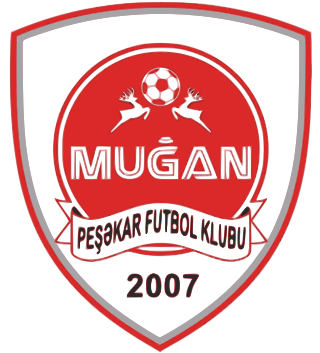
Mughan FK was an Azerbaijani football club, based in Salyan. The club reached the Azerbaijan Premier League for the first time in 2008–2009. The club was first promoted after FK Masallı withdrew for the 2008/09 season. On 31 October 2008, FK NBC Salyan changed its name to FK Mughan.
Muğanlı is a village and municipality in the Sharur District of Nakhchivan Autonomous Republic, Azerbaijan. It is located 4 km away from the district center, on the plain. Its population is busy with grain-growing, tobacco-growing, vegetable-growing, foddering, vine-growing and animal husbandry. There are secondary school, library, club, mosque and a medical center in the village. It has a population of 1,090.
Tālīsh is a region in the southwestern coast of the Caspian Sea. It is a homeland of the indigenous Talysh people, who inhabit the region and speak the Talysh language. The territory and the language set apart Talish from its neighbors.

The Lenkoran uezd or Talysh uezd was a county (uezd) within the Baku Governorate of the Russian Empire, and then of the Azerbaijan Democratic Republic and the Azerbaijan SSR until its formal abolishment in 1929. The county was located on the southern part of the governorate, bordering Caspian sea to the east, Javad uezd to the north, and Iran to the southwest. The administrative centre of the county was the city of Lenkoran.
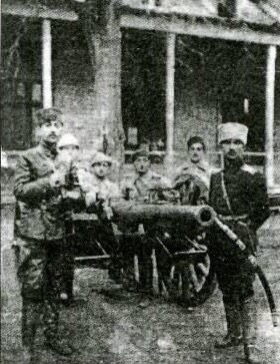
The Mughan clashes or Mugan events were a confrontation between Russian Whites, Bolsheviks and Azerbaijani forces in Mugan during March 1918 to August 1919, in the context of the Russian Civil War. As a result, the Mugan Soviet Republic became part of the Azerbaijan Democratic Republic.

Mil-Mughan Economic Region is one of the 14 economic regions of Azerbaijan. It borders Iran to the south, as well as the economic regions of Shirvan-Salyan, Central Aran, and Karabakh. The region consists of the districts of Beylagan, Imishli, Saatly, and Sabirabad. It has an area of 5,670 square kilometres (2,190 sq mi). Its population was estimated to be 522,600 in January 2021.

















